When deciding on your dream van, you may be considering getting a van with 4-wheel-drive (4wd, 4×4, AWD, etc). But do you really NEED a 4×4 van? This post compares the most important differences between 2wd vs 4wd vans. Sure, having a 4wd van will certainly make your campervan more capable off-road. And it can really save you from getting stuck in places where 2wd vans would struggle.
But when you consider the massive price increase of a 4wd van, you will probably have to question if it’s really necessary. The answer depends on how you intend to use your van, and if that justifies the extra cost of a 4wd van.
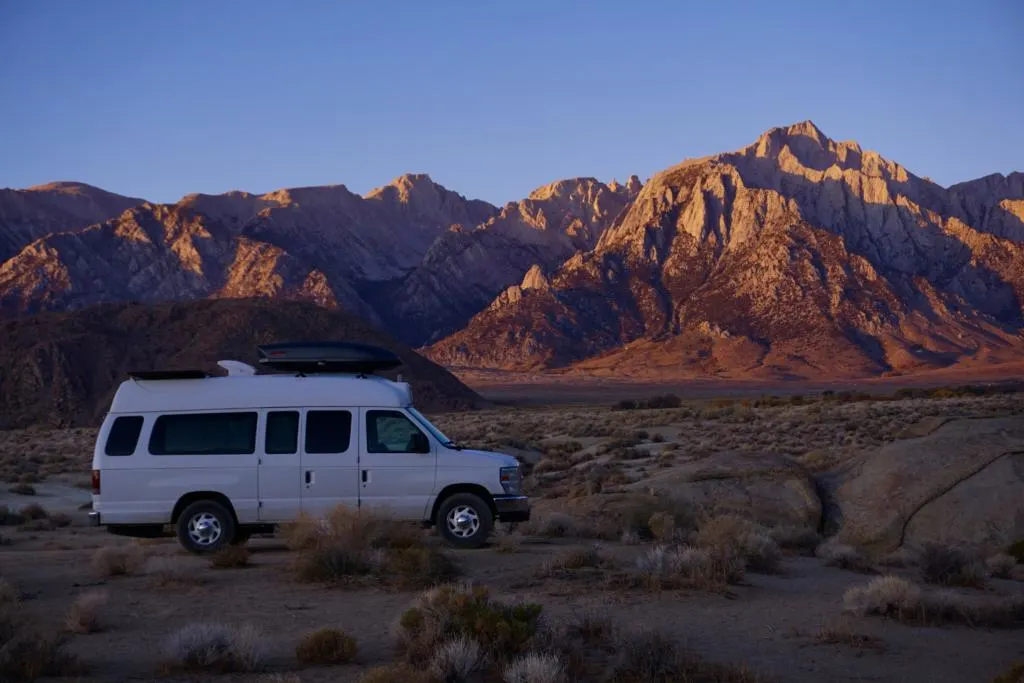
And just so our personal bias is out in the open, we drive a 2010 Ford E-350 that is only RWD. And so far, all of our driving has been in the USA, and mostly the Southwest where road conditions tend to be dry. But our RWD van has taken us to so many amazing remote places, over thousands of miles of dirt roads. We have only gotten truly stuck two times and we were able to do self-recovery both times.
Of course, everyone would love to have 4×4 if price wasn’t an issue. And our stance is that for most people, the additional cost of a 4wd van just isn’t worth it. But there are exceptions, so let’s get into the debate.
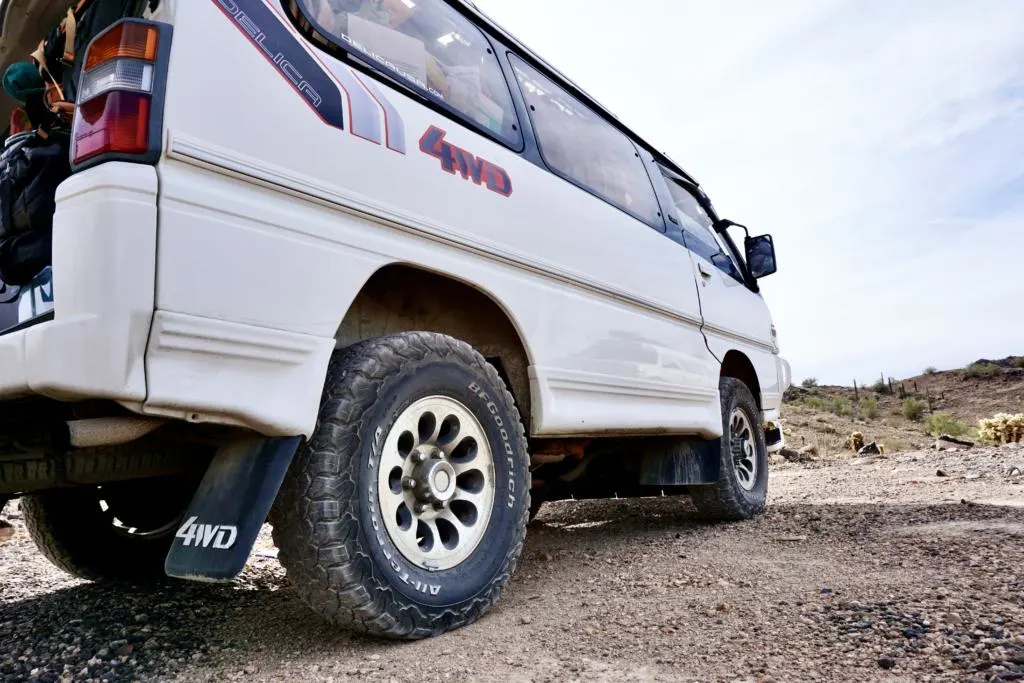
2WD Vs 4WD Vans
First, a quick explanation. Four-wheel-drive (or 4wd, 4×4, AWD) is when the engine can provide power to all four wheels simultaneously. While two-wheel-drive (or 2wd) is when the engine only powers the front or rear wheels. And the two types of 2wd are rear-wheel-drive (RWD) and front-wheel-drive (FWD) which are exactly what they sound like. Note that FWD does not stand for four-wheel-drive.
4WD vs AWD
The two common types of four-wheel-drive are 4WD and AWD.
All-wheel-drive (AWD) is an automatic system that is designed for continuous use on pavement. The vehicle’s computers monitor wheel slip and selectively adjust the torque to each wheel.
Four-wheel-drive (4WD, 4×4) is a selective drivetrain that allows the driver to manually switch between 2wd and 4wd. When 4wd is engaged, the center differential is locked and all the wheels spin at the same rate no matter what. 4×4 is better for very low traction conditions where maximum torque is needed.
Off-Road Typically Just Means Dirt Road
It may be a little confusing, but most of the time people talk about off-roading, they are really just talking about dirt roads. Which are technically still roads, but just not paved. True off-roading, like no roads at all, is much less common because not many places allow vehicles to drive anywhere. So through most of this article when I say off-road, I usually just mean a road that isn’t paved.
Traction Versus Clearance
It’s common for people to conflate traction and ground clearance as the same thing. But they are really two separate challenges of off-road driving.
Generally, if we’re just talking about dry dirt roads, then any 2wd van will be able to maintain traction. But you may still have an issue with clearance if the road has large rocks, ruts, or abrupt pitch changes. Even a 2wd van can have ground clearance with lifted suspension and larger tires.
But traction is really the primary issue when choosing between 2wd vs 4wd vans. So, how do you know if you need a 4×4?
What Kinds Of Places Will You Drive?

While you may not know exactly where you want to go with your campervan (and that’s fine), you probably have a rough idea. Under the umbrella of Vanlife, there are all kinds of people.
Some folks just stick around cities and towns and hardly ever leave paved roads. While others specifically design their campervan as an off-roading machine and are interested in off-roading as a hobby unto itself.
But most of us probably fall somewhere in the middle. We simply want to travel to places that interest us. And whether that’s on pavement or some rocky dirt roads, we don’t care. For most campervan owners, a dirt road is just a means to get to some cool campsite or trailhead.
So what kind of places do you see yourself driving?
Special Conditions (Mud, Sand, Snow, Ice)
The lowest traction situations are mud, sand, snow, and ice. If you think you might encounter any of these on a regular basis, you should highly consider 4wd (or AWD).
Mud
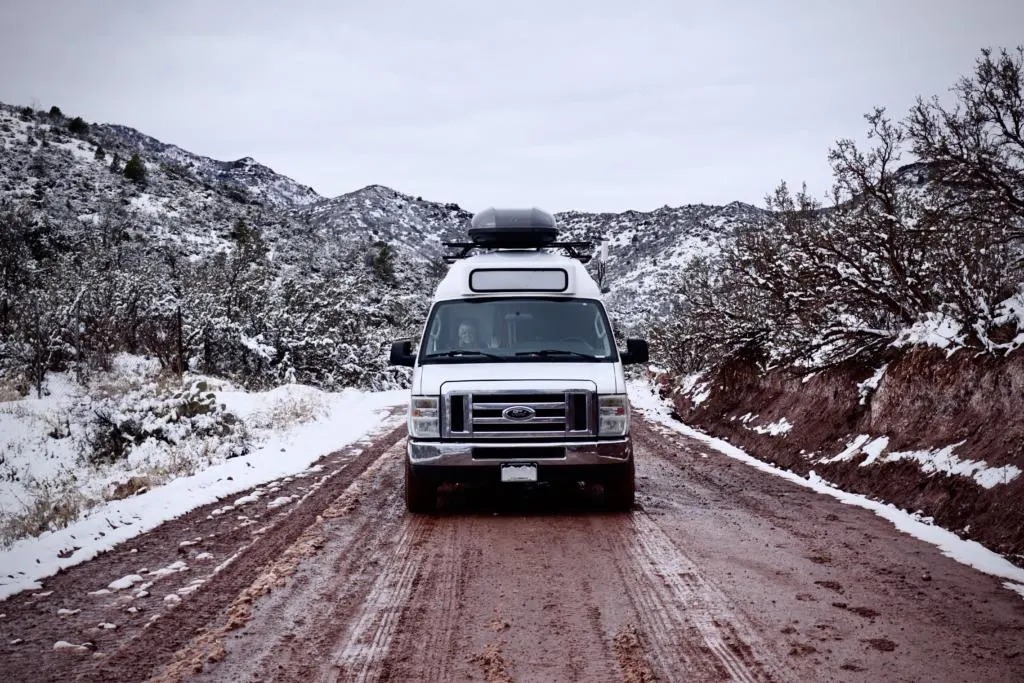
Most of the mud we have experienced is on dirt roads with recent rain or melting snow. But this tends to be just in limited patches and not very deep. The worst kinds of mud are found in the wettest climates (The Pacific Northwest, The South, etc.) Some places in the US, “mudding” is even considered a hobby unto itself. But as long as you do go out searching for deep mud, you can probably handle whatever you encounter with 2wd.
Sand

The most challenging sand conditions are typically found on beaches or sand dunes. If you plan to spend a lot of time driving on beaches, then it may be worth getting a 4wd van for the added traction. It’s very easy for a heavy campervan to get bogged down in soft sand. However, some beaches have very hard-packed sand, so its not strictly necessary to have 4wd.
Snow and Ice

Winter conditions are probably the most dangerous conditions of them all because it’s common to lose traction while the vehicle is moving. And that can lead to sliding off a road or into oncoming traffic. So the real danger of winter driving is not being able to stop or control a skid.
HOWEVER, 4wd or AWD vehicles don’t provide any extra benefit to help you stop faster or steer when decelerating. When you are applying the brakes, your tires provide the same amount of traction whether it’s 2wd or 4wd. So having a good set of winter tires with plenty of tread left is super important for winter driving.
But 4wd and Awd do provide some traction benefits when accelerating and cruising.
Which is better for Snow and Ice, 4wd or Awd?
All-wheel-drive is better for snowy and icy conditions because it’s works automatically. So it doesn’t require any input from the driver to react to highly variable traction changes due to patches of snow and ice. AWD can automatically detect changes in traction and make adjustments to prevent a skid. 4wd doesn’t have this benefit on pavement because you have to manually switch between 2wd and 4wd. And it’s not always clear what is icy and what isn’t.
However, in the really deep unplowed snow a 4×4 is better (AWD helps too). Deep unplowed snow is similar to mud and sand, in that a heavy campervan’s wheels can sink in and get stuck. But if you can clearly see how deep the snow is, you can switch to 4×4 and churn it up. Then just switch back to 2wd when you return to clear pavement, because 4×4 doesn’t let the wheels spin at different speeds when taking corners. This causes the wheels to skip and shudder.
So with both drivetrains, having all four wheels powered can prevent you from getting stuck. But for most of us, plowed (or poorly plowed) pavement accounts for most of our winter driving.
And I don’t know about you, but I would rather be stuck in deep snow in my driveway than lose control on an icy highway going 50mph. So give me the AWD all day in winter conditions.
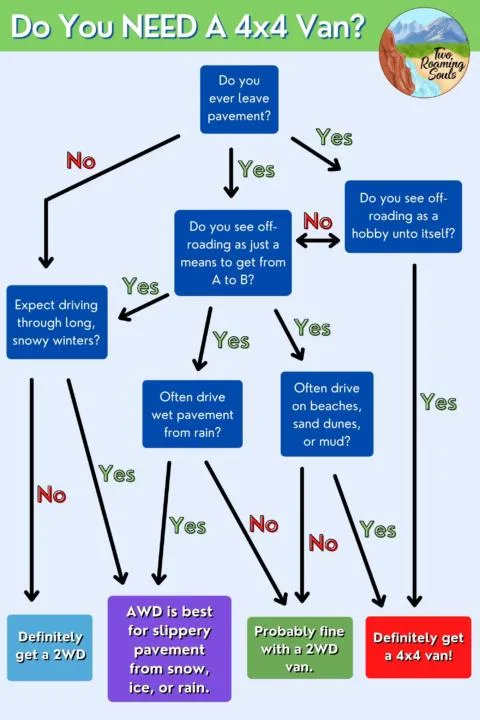
Will You Even Want To Push The Limits Off-Road?
Sometimes our dreams of rugged off-road excursions don’t quite match up with the reality of owning a campervan. Once you have invested lots of money into your campervan conversion, are you really going to want to beat it up on some really rough roads?
No matter how sturdy your conversion is, certain roads are just gonna rattle your home on wheels to death. Things may break, personal belonging will be flying off the shelves, and you could do serious damage to your conversion or the van itself. And having 4wd doesn’t make a bumpy road any less bumpy.
This is where we see a major difference between us and serious off-roaders and overlanders. While they may see their vehicle as more of a toy, we see our campervan as our home. So the amount of risk we are willing to take with our campervan is probably much lower than something like a Jeep, Truck, SUV.
We don’t go out seeking rough roads to destroy our campervan. But rather, rough roads are sometimes just a necessary evil to get to those epic campsites.
Is a 4×4 Van Actually That Capable?
The answer is yes, but sometimes no. A 4×4 campervan can be a very capable off-roading vehicle in many situations. But there are certain weaknesses that campervans have when compared to traditional 4×4 vehicles.
Long Wheelbase
One weakness of vans is the length of the wheelbase (the distance between the front and rear axle). Most campervans, especially the extended versions have very long wheelbases. This makes them more likely to bottom out when going over humps. This is known as the breakover angle.
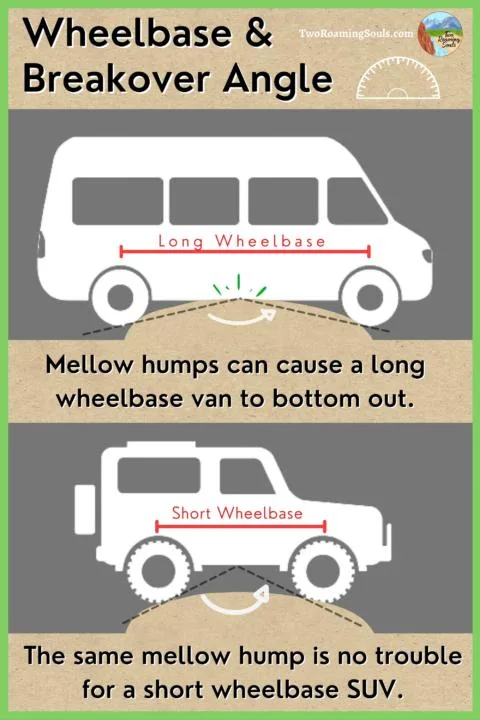
Approach and Departure Angles
Another negative of campervans is that they tend to have long tails and sometimes noses too. That is, the front and rear bumper of the van extend far past the axles This decreases the approach and departure angle significantly. These angles measure how abrupt of a pitch change your van can handle before scraping the front or rear bumper.
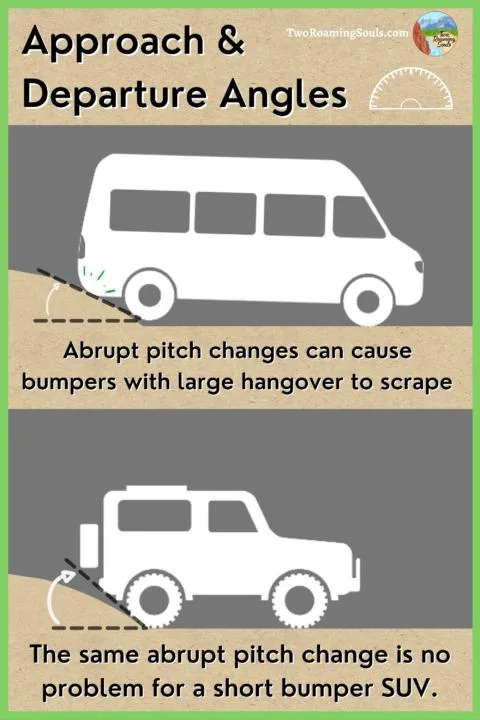
Less Maneuverability
The longer wheelbase also means bigger turning radius and less maneuverability, which is commonly an issue on narrow dirt roads.
Heavier
While weight is generally a good thing for traction, it is a negative in soft conditions. A heavy campervan will more easily sink into soft mud, sand, or snow and possibly get stuck, where a lighter 4×4 vehicle might ‘float’ over.
So all this is to say, don’t get a 4×4 van expecting to go toe-to-toe with a 4×4 Jeep.
Notable Differences Of 2wd Vs 4wd Vans
Price
The main thing that prevents most people from getting a van with 4wd or AWD is the cost. A four-wheel-drive van can cost an average of $5-10K more than a comparable 2wd van. This dramatic price difference is enough to make most people deeply consider how much they need 4×4.
A New 2021 Mercedes Sprinter costs about $8k more for a 4×4
A New 2021 Ford Transit costs about $4k more for an AWD.
And owners of used 4wd vans generally know that they have something special and will charge appropriately for it. Or to have an aftermarket 4×4 conversion (like a Ford Quigley 4×4) is about $10-14k. And people will probably try to recoup some of that cost when re-selling their 4×4 van to you.
Our feeling is that for most people, the several thousand-dollar price difference isn’t worth it. It’s just hard to justify spending thousands more if a 2wd van can get you most of the places you want to go.
Rarity of 4×4 and AWD Vans
The other issue is that 4wd vans are simply way less common. So if you are in the market for only 4wd vans, then it severely limits your options.

I made a list of every van on the market with 4×4 and AWD.
Fuel Efficiency
A 4wd van is generally heavier than a 2wd and that results in less fuel efficiency. Only typically a few miles per gallon, but potentially still a factor nonetheless. Over thousands of miles the total price of fuel may be significant when comparing 2wd vs 4wd vans.
Parts and Service
4wd vans are usually more expensive to service and qualified mechanics are harder to find. Parts may also be more expensive or hard to find in remote areas.
Traveling Abroad
I have mostly been talking about typical driving conditions in the US, since that’s mostly where we live and travel. And the roads in the US tend to be pretty well maintained, even the dirt ones. But we have heard that other countries can have way gnarlier roads. So traveling in other countries may be another reason to consider four-wheel-drive vans.
Conclusion | Do You NEED A 4×4 Van?
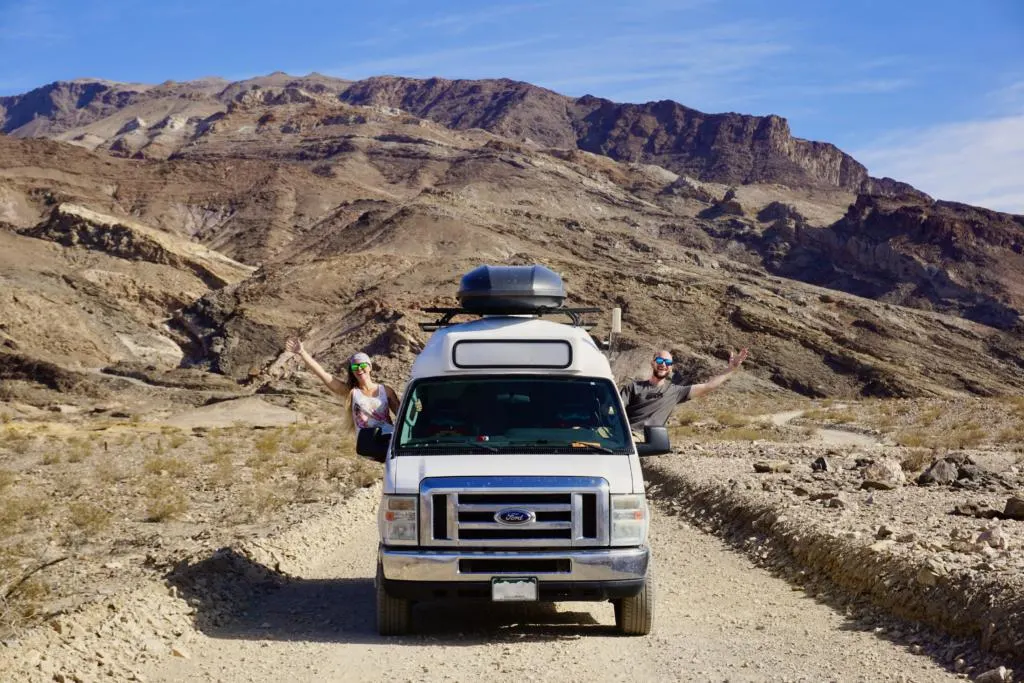
So for most people, we would say no, you don’t need a 4×4 van. There’s plenty of situations where four-wheel-drive is ‘nice to have’. But for the vast majority of conditions it’s not essential. And when you compare the price of 2wd vs 4wd vans, most people will find that it doesn’t makes sense for their budget.
We personally find our RWD campervan to be plenty capable for our adventures, and we go off-road nearly every day. We’ve driven thousands of miles on dirt roads, and rarely felt limited by our two-wheel-drive van. The two times we have been stuck we have been able to do self-recovery.
But there are several things that everyone who drives off-road should do.
Invest In Good Tires!!!
The first thing is TIRES!!! Every campervan should have a set of high-quality tires. The debate over 2wd vs 4wd vans is completely useless if you don’t have good tires.
We recommend all-terrain tires for the best all-around performance. Unless you will encounter lots of winter conditions, then I would get tires optimized for snow and ice.
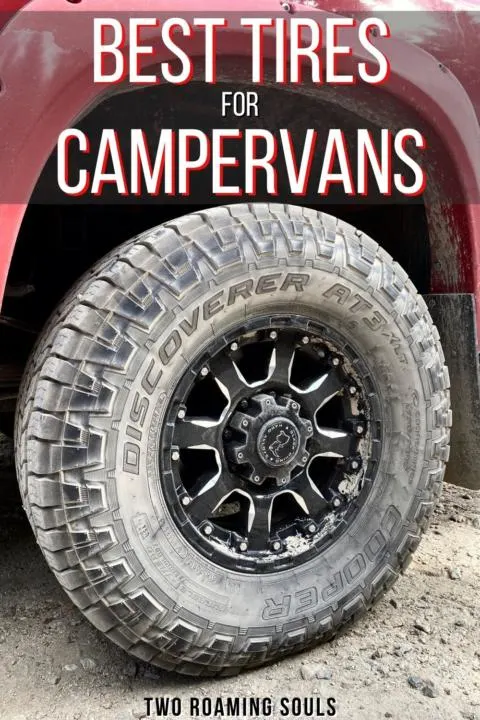
Recovery Gear
The second is investing in the essential recovery gear items. A shovel, tire deflators, air compressor, and traction boards are critical tools for performing a self-recovery if you get stuck.
Practice using them in moderate conditions, so that you know how to use them when it really counts.
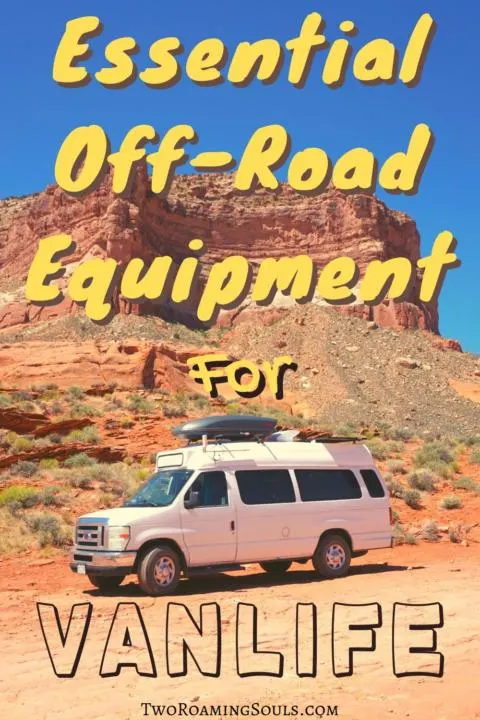
Drive Smart
The last topic is driver ability and decision-making, some of which only come with experience. So get out there and get some practice. Start in conditions that you are comfortable with and advance from there. Do your research, avoid bad weather, and trust your gut. Knowing how to choose lines, safe turn-arounds, and firm camp spots can be the difference between getting stuck and making it just in time to enjoy a beer for an epic sunset.
Help Share ‘2wd vs 4wd Vans | Do You Really Need 4×4?’ On Pinterest!
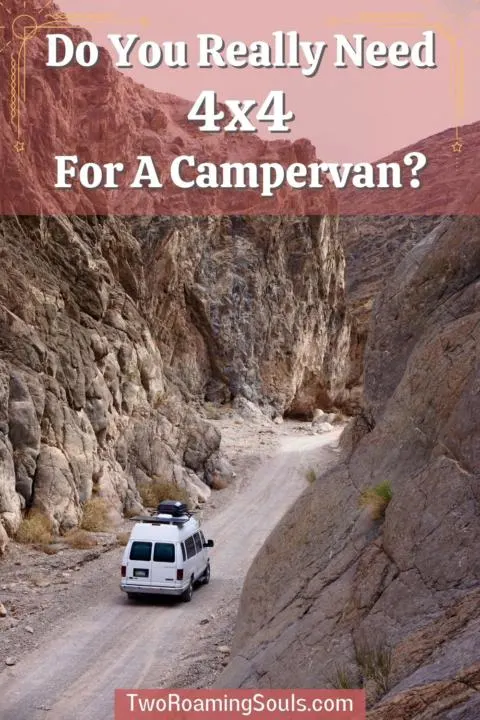
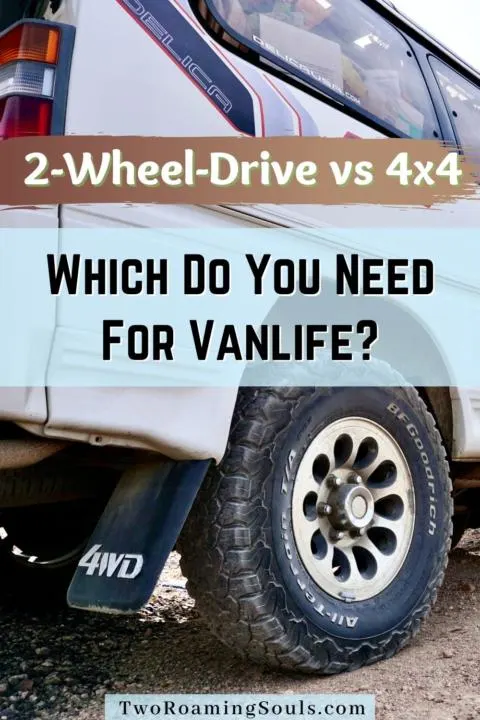

Ford Transit vs Transit Connect: Which Is Better For Vanlife? - tworoamingsouls
Wednesday 24th of May 2023
[…] The AWD Transit will perform the best (compared to other Transits) in low traction situations like: snow, dirt, sand, mud, and rain. But considering that an AWD model costs about $4,000 dollars more, you might reconsider whether you really need an AWD camper van. […]
What's The Difference Between Mercedes Sprinter 1500, 2500, 3500, 3500XD, and 4500 - tworoamingsouls
Thursday 6th of April 2023
[…] 4×4 Sprinters are only available in 2500 and 3500 models. But 4×4 Sprinters are more expensive and in limited supply, so may want to consider whether or not you really need 4WD? […]
Will Electric Vans and EV Revolution Change Vanlife? - tworoamingsouls
Sunday 6th of June 2021
[…] But do you even need a four-wheel-drive van to get off-road? I explain why it’s not a dealbreaker in this post here. […]
All Vans With 4x4 or AWD (in the US) - tworoamingsouls
Wednesday 24th of February 2021
[…] That’s the complete list of minivans and vans with 4×4 or AWD in the US. For those who insist on have four-wheel drive or all-wheel drive, these are the only factory options. But this may leave you wondering, do you really NEED a 4×4 van? […]